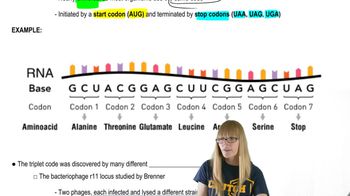Contrast the roles of tRNA and mRNA during translation, and list all enzymes that participate in the transcription and translation process.
Table of contents
- 1. Introduction to Genetics51m
- 2. Mendel's Laws of Inheritance3h 37m
- 3. Extensions to Mendelian Inheritance2h 41m
- 4. Genetic Mapping and Linkage2h 28m
- 5. Genetics of Bacteria and Viruses1h 21m
- 6. Chromosomal Variation1h 48m
- 7. DNA and Chromosome Structure56m
- 8. DNA Replication1h 10m
- 9. Mitosis and Meiosis1h 34m
- 10. Transcription1h 0m
- 11. Translation58m
- 12. Gene Regulation in Prokaryotes1h 19m
- 13. Gene Regulation in Eukaryotes44m
- 14. Genetic Control of Development44m
- 15. Genomes and Genomics1h 50m
- 16. Transposable Elements47m
- 17. Mutation, Repair, and Recombination1h 6m
- 18. Molecular Genetic Tools19m
- 19. Cancer Genetics29m
- 20. Quantitative Genetics1h 26m
- 21. Population Genetics50m
- 22. Evolutionary Genetics29m
11. Translation
Translation
Problem 6
Textbook Question
The α chain of eukaryotic hemoglobin is composed of 141 amino acids. What is the minimum number of nucleotides in an mRNA coding for this polypeptide chain?
 Verified step by step guidance
Verified step by step guidance1
Understand that each amino acid in a polypeptide chain is encoded by a sequence of three nucleotides in mRNA, called a codon.
Identify the total number of amino acids in the α chain, which is given as 141 amino acids.
Calculate the number of nucleotides needed to code for these amino acids by multiplying the number of amino acids by 3, since each amino acid corresponds to 3 nucleotides: .
Remember to consider the stop codon, which signals the end of translation but does not code for an amino acid. The stop codon also consists of 3 nucleotides and must be included in the total nucleotide count.
Add the 3 nucleotides of the stop codon to the previous total to find the minimum number of nucleotides in the mRNA: .
 Verified video answer for a similar problem:
Verified video answer for a similar problem:This video solution was recommended by our tutors as helpful for the problem above
Video duration:
1mPlay a video:
Was this helpful?
Key Concepts
Here are the essential concepts you must grasp in order to answer the question correctly.
Genetic Code and Codons
The genetic code consists of nucleotide triplets called codons, each specifying a single amino acid. Since each amino acid is encoded by a sequence of three nucleotides, the length of the mRNA coding region depends on the number of amino acids in the protein.
Recommended video:
Guided course

The Genetic Code
mRNA Structure and Translation
mRNA carries the genetic information from DNA to the ribosome for protein synthesis. The coding region of mRNA includes codons for amino acids and a stop codon that signals termination of translation, which is essential for determining the total nucleotide count.
Recommended video:
Guided course

Translation initiation
Stop Codon and Its Role
A stop codon (UAA, UAG, or UGA) signals the end of translation and does not code for an amino acid. Therefore, the mRNA must include an additional three nucleotides beyond those coding for amino acids to properly terminate protein synthesis.
Recommended video:
Guided course

Translation Termination

 7:58m
7:58mWatch next
Master Translation initiation with a bite sized video explanation from Kylia
Start learningRelated Videos
Related Practice
Textbook Question
754
views
